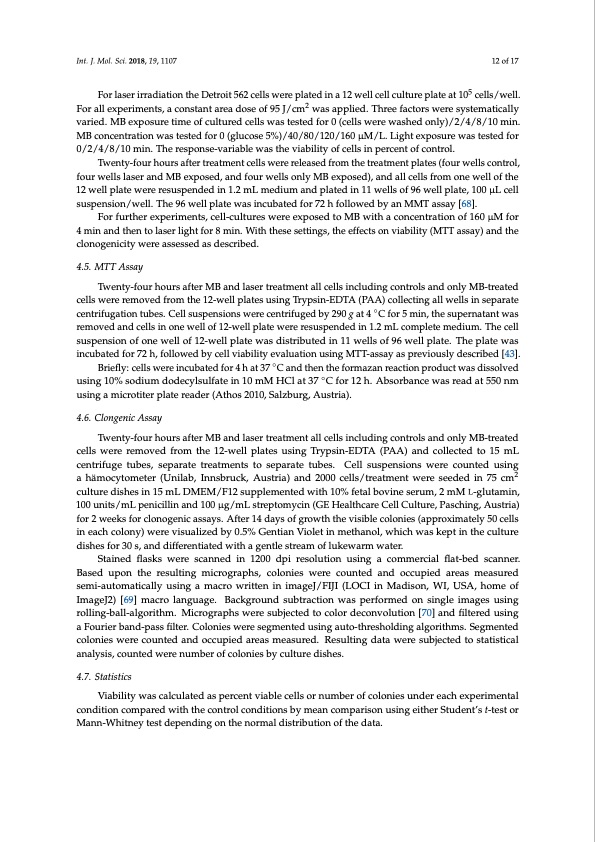
PDF Publication Title:
Text from PDF Page: 012
Int. J. Mol. Sci. 2018, 19, 1107 12 of 17 For laser irradiation the Detroit 562 cells were plated in a 12 well cell culture plate at 105 cells/well. For all experiments, a constant area dose of 95 J/cm2 was applied. Three factors were systematically varied. MB exposure time of cultured cells was tested for 0 (cells were washed only)/2/4/8/10 min. MB concentration was tested for 0 (glucose 5%)/40/80/120/160 μM/L. Light exposure was tested for 0/2/4/8/10 min. The response-variable was the viability of cells in percent of control. Twenty-four hours after treatment cells were released from the treatment plates (four wells control, four wells laser and MB exposed, and four wells only MB exposed), and all cells from one well of the 12 well plate were resuspended in 1.2 mL medium and plated in 11 wells of 96 well plate, 100 μL cell suspension/well. The 96 well plate was incubated for 72 h followed by an MMT assay [68]. For further experiments, cell-cultures were exposed to MB with a concentration of 160 μM for 4 min and then to laser light for 8 min. With these settings, the effects on viability (MTT assay) and the clonogenicity were assessed as described. 4.5. MTT Assay Twenty-four hours after MB and laser treatment all cells including controls and only MB-treated cells were removed from the 12-well plates using Trypsin-EDTA (PAA) collecting all wells in separate centrifugation tubes. Cell suspensions were centrifuged by 290 g at 4 ◦C for 5 min, the supernatant was removed and cells in one well of 12-well plate were resuspended in 1.2 mL complete medium. The cell suspension of one well of 12-well plate was distributed in 11 wells of 96 well plate. The plate was incubated for 72 h, followed by cell viability evaluation using MTT-assay as previously described [43]. Briefly: cells were incubated for 4 h at 37 ◦C and then the formazan reaction product was dissolved using 10% sodium dodecylsulfate in 10 mM HCl at 37 ◦C for 12 h. Absorbance was read at 550 nm using a microtiter plate reader (Athos 2010, Salzburg, Austria). 4.6. Clongenic Assay Twenty-four hours after MB and laser treatment all cells including controls and only MB-treated cells were removed from the 12-well plates using Trypsin-EDTA (PAA) and collected to 15 mL centrifuge tubes, separate treatments to separate tubes. Cell suspensions were counted using a hämocytometer (Unilab, Innsbruck, Austria) and 2000 cells/treatment were seeded in 75 cm2 culture dishes in 15 mL DMEM/F12 supplemented with 10% fetal bovine serum, 2 mM L-glutamin, 100 units/mL penicillin and 100 μg/mL streptomycin (GE Healthcare Cell Culture, Pasching, Austria) for 2 weeks for clonogenic assays. After 14 days of growth the visible colonies (approximately 50 cells in each colony) were visualized by 0.5% Gentian Violet in methanol, which was kept in the culture dishes for 30 s, and differentiated with a gentle stream of lukewarm water. Stained flasks were scanned in 1200 dpi resolution using a commercial flat-bed scanner. Based upon the resulting micrographs, colonies were counted and occupied areas measured semi-automatically using a macro written in imageJ/FIJI (LOCI in Madison, WI, USA, home of ImageJ2) [69] macro language. Background subtraction was performed on single images using rolling-ball-algorithm. Micrographs were subjected to color deconvolution [70] and filtered using a Fourier band-pass filter. Colonies were segmented using auto-thresholding algorithms. Segmented colonies were counted and occupied areas measured. Resulting data were subjected to statistical analysis, counted were number of colonies by culture dishes. 4.7. Statistics Viability was calculated as percent viable cells or number of colonies under each experimental condition compared with the control conditions by mean comparison using either Student’s t-test or Mann-Whitney test depending on the normal distribution of the data.PDF Image | Photodynamic Low Level Laser Squamous Cell Carcinoma

PDF Search Title:
Photodynamic Low Level Laser Squamous Cell CarcinomaOriginal File Name Searched:
ijms-19-01107.pdfDIY PDF Search: Google It | Yahoo | Bing
Cruise Ship Reviews | Luxury Resort | Jet | Yacht | and Travel Tech More Info
Cruising Review Topics and Articles More Info
Software based on Filemaker for the travel industry More Info
The Burgenstock Resort: Reviews on CruisingReview website... More Info
Resort Reviews: World Class resorts... More Info
The Riffelalp Resort: Reviews on CruisingReview website... More Info
| CONTACT TEL: 608-238-6001 Email: greg@cruisingreview.com | RSS | AMP |